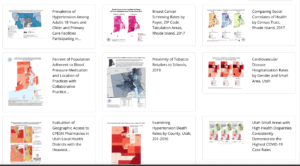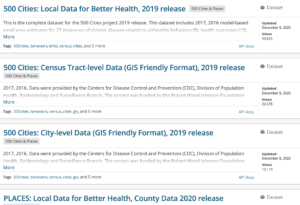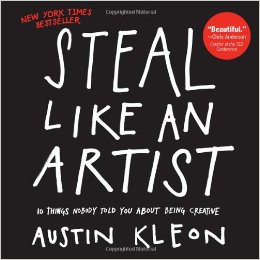US Tobacco Control Laws Database
American Nonsmoker’s Rights Foundation maintains data on US state and local tobacco control laws and policies related to marijuana.
US Tobacco Control Laws Database

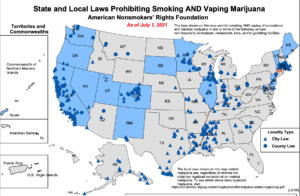
Additionally, it provides links to model ordinances and policies that can serve as a guidance document for jurisdictions that are seeking to implement a policy.
Geographic Health Equity Alliance
Data, tools, and resources for lowering geographic health disparities related to tobacco and cancer
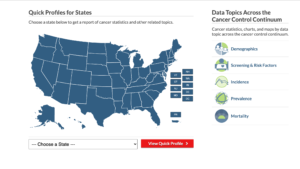
The website provides rich tools and resources on various topics with a focus on place-based disparities.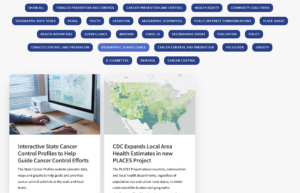
GIS Exchange Map Gallery
CDC’s GIS Exchange Map Gallery for demonstrating how maps are used for noncommunicable diseases and prevention

CDC’s 500 cities and places portal
Interesting crowdsourced applications developed by GIS Corps in response to the pandemic
During the time of pandemic, GISCorps —group of volunteers who contribute in spatial data creation for humanitarian cause — developed interesting crowdsourced applications and web-mapping applications. These included allowing users to find vaccination sites based on where they live, identify grocery stores that practice social distancing and follow the safety protocol as well as report those that don’t adhere to the guidelines.
Below are some interesting applications developed by GIS Corps:
Here is an example of COVID-19 testing sites, type of site such as drive-through or not and the type of test that is offered.
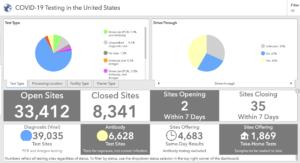
Here is another example of a crowdsourced app on safety and 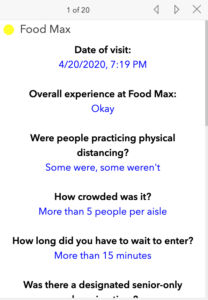 customer experience at grocery stores during the pandemic. This is how users can report their overall experience and alert other consumers about the safety protocols followed by the store, waiting time, and information that would help other consumers make a decision about visiting a particular store.
customer experience at grocery stores during the pandemic. This is how users can report their overall experience and alert other consumers about the safety protocols followed by the store, waiting time, and information that would help other consumers make a decision about visiting a particular store.
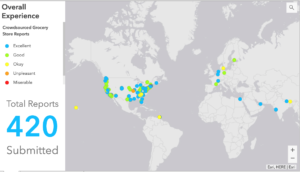
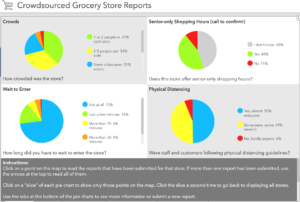
Additional examples of the apps related to COVID-19 can be found here.
Web-GIS in the time of pandemic
During the pandemic the number of web-GIS applications proliferated. Below are the link to the number of applications developed in the US.
Here is the link to some of the global applications developed in individual countries.
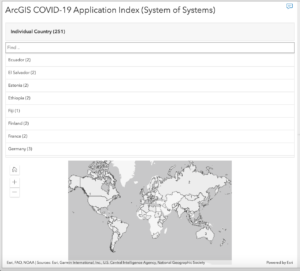
Here is the link to the US specific applications.
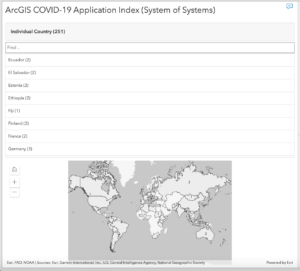
Book Review: Steal Like An Artist
As an academic or as someone who enjoys writing to discover new trends and patterns, I view my quest to come up with research ideas as a creative endeavor. I also associate being creative requires an entrepreneurial spirit — with the difference being that a real entrepreneur invests capital in some form to get returns, while a scientist or a writer has to invest his or her time to come up with ideas that might bear a return or not, depending on whether that research gets funded or whether that idea makes it into a fine editorial piece or not.
If you view that your work requires some degree of creativity, then Steal like An Artist is just a less than 100 pages book that would inspire you to develop some principles in your pursuit of creative ideas. Interestingly, the entire book consists of cartoons/graphics with short notes around different principles that the author recommends.
The three principles that resonated with me the most are:
- Start from the mundane to make something extraordinary: Often we are trying to think “outside the box”. But one has to be inside the box first and be able to see things from multiple perspectives before one can step outside the box and see a different paradigm. The book discusses examples of successful artists and painters and singers who first emulated their role models and in the process by doing so, they found their distinct identity. Drawing a parallel to this, as a researcher or scientist, this could be following an existing method applied by several others in the field; then identifying a flaw in it or a marginal improvement that adds one’s distinct identity and viewpoint, to produce something new.
- Go unwired from technology: I really love this because it is so easy to get swamped in the flood of information at a click of a mouse and multiple tabs open in your browser. As a researcher when I want to come up with new ideas, I like to stay away from screen and draw mind maps around a central theme that I would like to explore. By doing so I am often able to discover what I already know on the topic, or the different areas that I’d like to explore around the topic, and if nothing then at least it gives me a structure around the idea that I need to build on my writing or my search query in Google scholar. Similarly, when I already have a lot of information, I again step back from the screen, and do the same exercise – in this instance, to develop a coherent structure around all the information that I already have and then use my laptop to type it.
- Go on a creative date everyday and consistently: All creative work is a pile up of “boring”, “mundane” tasks performed consistently to make something extraordinary. I agree to this by far the most because consistency is the most important principle in writing or solving a problem. There are several days when we feel we are being “unproductive”, but being consistent in working on it is the only way to get a breakthrough. As Woody Allen said that success is about 80 percent just showing up.
Book Review: Geek Heresy: Rescuing Social Change from the Cult of Technology
Why is it that a job posted on LinkedIn is for anyone to apply, but the person who is most likely to get an interview call is someone who either knows the HR or knows someone inside the company who is on his LinkedIn network? Why is it that even though internet is widely available in China, it cannot break the censorship walls built by the Chinese government? Even when technology is available to everyone, why is it that highly motivated individuals use it very differently and for very different purpose then those who are less educated and have very less aspirations in life?
While technology can give equal access to everyone, it cannot replace social access that only few privileged people have, which guarantees their entry for a job interview after controlling for skills and education. Similarly, without the right political and social institutions, freely available internet access to everyone still does not guarantee access to unbridled information. Or even when technology is available for anyone, the more educated, ambitious, and highly motivated individual will be very discerning in the use of internet for educational purpose as opposed to someone who would use it more for entertainment. Sounds like common sense, isn’t it? As much as it sounds so obvious, Kentaro’s book is an eye-opener for anyone who believes that technology can be an end in itself in solving certain social problems. Kentaro Toyoma makes a compelling case that technology cannot have any impact without nurturing the right political and social institutions; it cannot transform an individual who lacks the right motivation, judgment to make the right choices, and self-discipline and control to follow through the right choices . Though written by a computer scientist, this book is more written from the perspective of ethics and philosophy.
I met Kentaro when I had just started my career as a journalist. Kentaro was heading then Microsoft India Research Foundation where he was involved in interesting initiatives that harnessed technology for social change. The book is based on Kentaro’s experiences in India as a part of Microsoft Research Foundation. It was during this journey that he encountered several non-profits and organizations that were intending to drive social change through the use of technology such as one laptop per child and similar initiatives, but these intentions were not matched with the right outcome.
While the book has numerous examples and case studies of organizations that were successful in harnessing technology along with building human capacity to use it, it falls short to a certain degree on rigorous scientific evidence. Several examples are from education and micro lending space and based on anecdotal evidence based on his personal experiences with these organizations. The book could have been enriched by including more evidence from public health where it is commonly used to target patient adherence to treatment, follow-up plans, using text-based services that are designed to change key behaviors towards reducing the risk of certain diseases. Despite its shortcoming on rigorous scientific evidence from other fields like public health, the book is well-written, engaging, and drives home some of the fundamental principles that can predict success of a technology based program in transforming social change.
From macro-economists versus micro-economists to macro statisticians versus micro statistician: The gulf between big data and small data scientists
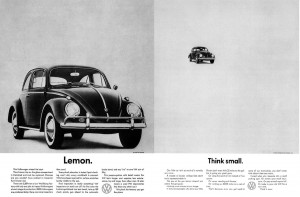 In the 1950’s and 60’s it was “Think small” ad for Volksgen’s Beatle car that marked a radical shift in an era that was dominated by large cars in the US. For anyone who studied advertising or works in the industry would recall this iconic add – considered as a classic in the field in several ways — but for the most part it created a new way of consumer thinking for the advantages of small cars versus big cars.
In the 1950’s and 60’s it was “Think small” ad for Volksgen’s Beatle car that marked a radical shift in an era that was dominated by large cars in the US. For anyone who studied advertising or works in the industry would recall this iconic add – considered as a classic in the field in several ways — but for the most part it created a new way of consumer thinking for the advantages of small cars versus big cars.
Today for someone in the field of data science, “big data” is the buzzword. More and more jobs are emerging in this area. Every day on my LinkedIn, I see several opportunities in this area. So I see the world of data science also facing a similar divide – big data versus small data. While we don’t hear much about small data as much as we hear about the term “big data” as it is more fancy, sexy, and requires highly sophisticated programming skills to model the problem, there are distinct problems and areas of application where each has its own place and utility.
Big data and some of its applications: Big data is associated with machine learning and applying algorithms to extract data from the web to search for pattern and trends based on millions of records. For instance, in text based analysis this would mean web crawling through millions of newspaper articles and editorials through which a computer can identify specific articles that a researcher or analyst is looking for. For a spatial statistician, this could mean employing computer algorithm to extract location information from millions of records about specific events of interest. The world of big data analytics is dominated by computer scientists, statisticians, political scientists interested in studying issues pertaining to conflicts, or public opinion. It is also dominated by companies and industries that are looking to capture consumer behavior and trends. So companies like Amazon and Google can model consumer pattern and forecast demand or decision-making.
Small data and its application: We don’t hear much of the term “small data”, but as a public health and policy professional, I see a lot of problems that need to be addressed in the field of public health, epidemiology, census that require one to deal with counts and small numbers that can be modeled correctly and be used to make valid inferences. This requires domain knowledge of distinct set of statistical models and tools. Organizations where knowledge of small area analysis and estimation would be helpful would be CDC, Census Bureau, and community level program planning and evaluation.
a) Survey methodology: For large scale health and population surveys implemented in developing countries, the sample is representative of the population at a larger regional scale, but often not for small geographic scale. In such a situation small area estimation techniques or interpolation is of interest to make inference about a geographic unit where sampling was not done on specific health outcome.
b) Sentinal Surveillance: This involves surveillance at a specific site or a location for detecting disease outbreaks or new cases of specific diseases. According to WHO sentinel surveillance is appropriate to gather high quality data when passive surveillance system ( generally based on data reported by health workers and health facilities) is not adequate to identify causal factors for certain diseases. However, because data is monitored at specific sites, hospitals, or locations, it may not be appropriate for detecting cases outside of the selected sites.
c) Community based program planning: In case of community and program planning, an application area would be improving a health intervention at a specific site and location. For instance, USAID allocates funds for HIV testing and treatment at specific sites and in several countries. Hence it might be interested in knowing which clinics are doing better in comparison to other clinics. According to the PEPFAR Annual report to the Congress, there exists a wide variation in disease burden and HIV risk at the sub-national level and sub-populations level. Hence, knowledge about distribution of cases around specific sites, uptake in the service utilization can help improve programs. Similarly, AidData, a collaboration between three universities, to track where aid money is going and in which programs by country and by year and based on the type of the project, works in the area of geospatial impact evaluation. Hence, it borrows traditional statistical methods such as difference-in difference and propensity score matching and other methods, but also takes into account site location of the project. It identifies sites where World Bank did not implement a project, thus acts as a control site. By accounting for location of the project implementation site, it considers heterogeneity in program outcomes while conducting impact assessments.
Economics as a discipline has always been demarcated between marco and micro economics. Is it time we divide statistics also as a discipline between macro and micro?
